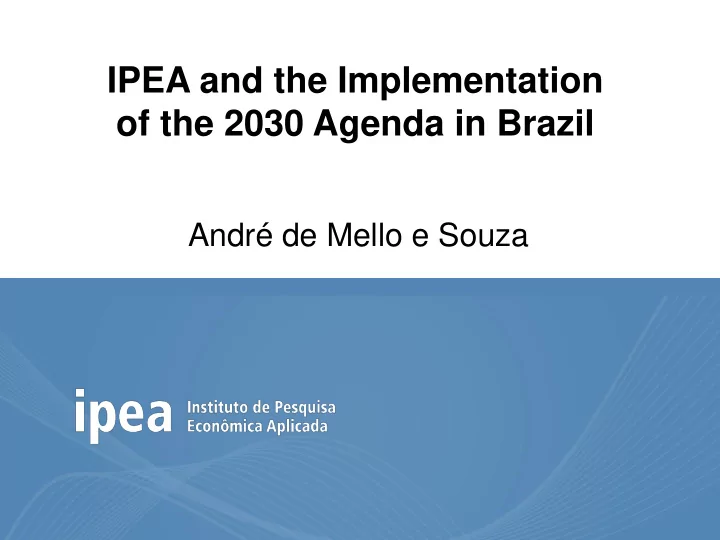

IPEA and the Implementation of the 2030 Agenda in Brazil André de Mello e Souza
Governance mechanism for the 1 Título 1 implementation of the 2030 Agenda in Brazil o
Governance mechanism for the implementation of the 2030 Agenda in Brazil Título 1 1
The National SDG Commission • Offers parity between governments and civil society in terms of their advisory role • Created to articulate and mobilize actors, as well as to foster dialogue with federative entities and civil society • Joint composition: 8-government and 8-civil society (selected by a call for applications) Título 1 1 • Assignments: • Prepare a Plan of Action for the implementation of Agenda 2030. • Prepare national voluntary reports (every 2 years). • Identify, systematize and disseminate good practices and initiatives that collaborate to reach the ODS. • Adapt ODS global goals and indicators to the Brazilian reality. • Develop tools to monitor the Agenda 2030. • Map public policies that contribute to the achievement of ODS. • Install Thematic Chambers within the Commission to address specific issues.
The 1st Voluntary Report of Brazil 2 Título 1
The 1st Voluntary Report of Brazil - Brazil presented its 1st. Voluntary Report on the Session of the UN High Level Political Forum, held from 10 to 19 July, 2017. - The process of preparing the Brazilian Report was coordinated by the Chiefs of Staff of the Presidency of the Republic and the Secretariat of Government. - The preparation of the Report was carried out in only two months. - IPEA was responsible for its technical content, based on data supplied Título 1 by the ministries. 1 - 22 ministries participated by sending information on activities and programs relevant to the achievement of the SDG targets. - The report focused on the themes and SDGs selected by the HLPF (SDGs 1, 2, 3, 5, 9 and 14). - For each SDG, the Report presented a brief diagnosis of the situation, existing government policies and programs that contribute to the achievement the respective goal, the progresses made and challenges confronted.
The Civil Society Report - Criticizes the ceiling on government spending, the pension reform and the labor reform. - Stresses the need for a tax reform. - Points to setbacks in the areas of poverty eradication, hunger control, Título 1 sustainable agriculture, health, gender equality, innovation and 1 infrastructure, water resources and the development of partnerships and effective means of implementation.
The Plan of Action of the National ODS 3 Título 1 Commission: Attributions of IPEA
The Technical Advisory Institutions of the National SDG Commission • IPEA and IBGE are members of the National SDG Commission as Permanent Technical Advisory Institutions, without the right to vote, with the following attributions: (Article 11, paragraphs 1 and 2): • IBGE will be responsible for coordinating and leading the discussion of the global indicators, for the collection and production of data, and for supporting the elaboration of proposals in the ambit of the periodical Título 1 reports. IBGE will propose indicators (Tier I and II). 1 • IPEA will be responsible for the production of studies, data analysis, and the preparation of periodic reports proposals that will support the National SDG Commission and the definition and monitoring of national indicators related to Agenda 2030. IPEA will propose targets. • Based on these attributions, IPEA and IBGE were invited to contribute to the elaboration of the Work Plan of the National Commission
IPEA’s Role in the National ODS Commission Plan of Action 1. Adaptation of the Global Targets to the Brazilian reality 2. Elaboration of Partial Reports which present diagnosis of the 3. Brazilian situation in relation to the 17 SDGs (T zero reports) Título 1 Adaptation of targets 1 T zero reports Evaluation of the coherence of policies to reach the goals 4. Elaboration of Country Reports (progress assessment) 5. Construction of future scenarios to reach the SDGs 6. Long Term Studies
Adapting Targets and Building Indicators • The 17 SDGs contain 169 global targets and 231 indicators. • According to Paragraph 5 of the UNGASS Resolution of 9/2015, the 2030 Agenda “(…) is accepted by all countries and is applicable to all, taking into account different national realities, capacities and levels of development and respecting national policies and priorities .” • It is therefore necessary to analyze the adequacy of the goals in relation to the Brazilian reality, taking into account our needs, circumstances, commitment of the country to the 2030 Agenda, the Plurianual Plans (PPA) Título 1 and the National Plans of existing Ministries. 1 • Previously, Brazil included five new goals and 61 new indicators in the MDGs that provided greater clarity and precision in identifying the challenges faced by the country. • The task of adapting the MDGs targets and indicators was also coordinated by IPEA, at the request of the Chiefs of Staff, with the valuable support of IBGE and of various ministries and agencies of the Federal Government, in addition to international organizations. • The process of adapting the targets of the SDGs will be once again the responsibility of IPEA.
Example of Target Adaptation to the Brazilian reality • SDG 4: “ Ensure inclusive and equitable quality education and promote lifelong learning opportunities for all”. • Target 4.5: “ By 2030, eliminate gender disparities in education and ensure equal access to all levels of education and vocational training for the vulnerable, including persons with disabilities, indigenous peoples, Título 1 and children in vulnerable situations”. 1 • Yet, women have been able to eliminate and reverse the gender gap in education in Brazil throughout the 20th century. • Afro- Brazilians form a considerable portion of the country’s vulnerable population, and need to be singled-out in the target.
Thank you! andre.souza@ipea.gov.br
Recommend
More recommend